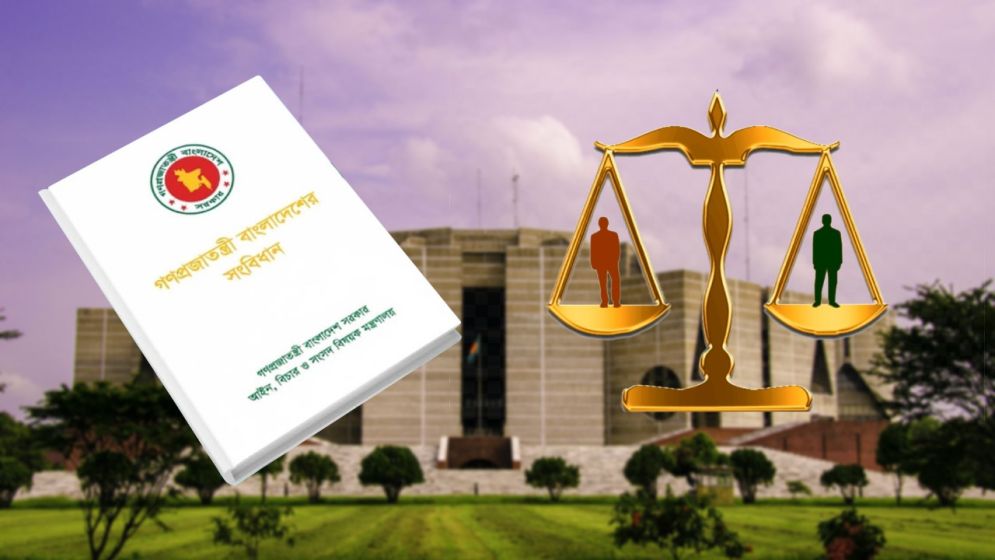Bangladesh’s push for Bicameralism: Will it be a step toward checks and balances?

When the Constitution Reform Commission of Bangladesh submitted its much-anticipated report to the chief adviser last Wednesday, one recommendation stood out amid the host of proposed changes: a call for the reform of the country’s parliamentary structure.
Specifically, the Commission suggested shifting from a unicameral legislature to a bicameral one—a move that could profoundly alter the dynamics of political governance in the nation.
Currently, Bangladesh operates with a single-chamber parliament composed of 350 members. Of these, 300 are directly elected from territorial constituencies, while the remaining 50 seats are reserved for women.
This structure has long been a fixture of the country’s political landscape, but now, as the Reform Commission’s report makes clear, there is significant momentum behind a shift to a two-chamber system.
Bicameralism is not a new concept in global governance. Countries such as the United States, the United Kingdom, India, Australia, and Canada have long used a two-chamber parliament, which divides legislative responsibilities between a lower house—where day-to-day politics are debated and decided—and an upper house, which is tasked with scrutinizing, revising, and providing additional oversight over legislation.
In the UK, this takes the form of the House of Commons and the House of Lords; in the US, the House of Representatives and the Senate fulfill similar roles.
In Bangladesh, the proposal for a bicameral legislature has gained considerable support for quite some time.
According to Dr. Ali Riaz, head of the Constitution Reform Commission, a wide range of stakeholders—including political parties—have endorsed the idea.
The central argument for this shift, Riaz explains, is the desire to prevent the centralization of power, advocating for a system of checks and balances between the two chambers of parliament.
The Bangladesh Nationalist Party (BNP), the most prominent political force right now, has been particularly vocal in supporting bicameralism.
In fact, it was one of the party's key proposals in its 31-point state reform agenda. The BNP believes that a two-chamber system could help restore balance to the state’s governance by integrating the expertise of specialists and professionals with the political voices already represented in the parliament.
Dr. Riaz elaborates on BNP’s stance, pointing to a troubling history of power consolidation in Bangladesh’s unicameral legislature.
“One of the reasons for this proposal is that the current parliament, when controlled by a single party or coalition, has passed laws that do not align with the democratic aspirations of the people,” he said.
He specifically referenced the controversial constitutional amendments—the 4th and 15th amendments—that, in his view, undermined democracy and human rights.
The core aim of bicameralism, according to Riaz, is to prevent the concentration of power in one party or coalition, thereby protecting the rights of citizens and ensuring that no laws are passed on a mere majority vote in a single chamber.
Without this safeguard, he argues, the country risks moving toward an autocratic system where the will of the people is subordinated to the whims of a powerful majority.
-67892970670cb.jpg)
Power distribution and
bringing balance
The argument for a bicameral legislature rests heavily on the principle of power distribution.
Proponents of the system contend that a second chamber would act as a critical counterweight to a dominant lower house, offering both a broader range of representation and additional oversight of legislation.
This dual-chamber system would also, ideally, provide a space for more deliberate, thoughtful policy-making—something that the current system, which has often been criticized for its political volatility and lack of long-term vision, has failed to achieve.
The proposal for parliamentary reform, as reported by Prothom Alo, suggests a shift to a bicameral system with a total of 505 seats across two chambers.
The lower house would consist of 400 seats, with elections held under the current system. Of these, 100 seats would be reserved for women, and members would be directly elected, maintaining the existing electoral process.
The upper house, on the other hand, would be made up of 105 members, selected through a proportional representation system. This would mean that political parties would receive seats in the upper house in proportion to their share of the vote in general elections.
Analysts say one of the major advantages of a bicameral system is its ability to provide more comprehensive representation of diverse groups within society.
By creating an upper chamber, the system could better accommodate various interests, from marginalized communities to minority groups.
In fact, provisions would be made to ensure these groups are represented in the upper house, with political parties required to include at least five members from marginalized communities among the 100 upper house members.
Additionally, the president would nominate five individuals from outside the political sphere, ensuring broader representation beyond party lines.
However, the proposal also comes with potential drawbacks, as some analysts point out.
A two-chamber legislature could slow down decision-making, as bills would need approval from both houses before becoming law. This added layer of scrutiny could delay the passage of key legislation.
Moreover, a bicameral system typically results in higher public spending, as maintaining two houses of parliament incurs additional administrative and operational costs.
There is also the concern that members of the upper house, who would be indirectly elected or nominated, may not be as accountable to the public as their counterparts in the directly elected lower house.
-6789298b5b40c.jpg)
How will the two-house
structure operate?
Dr. Riaz emphasized that the upper house would operate on a proportional basis, reflecting the distribution of votes in general elections. He also pointed to the intention of ensuring that minority groups have a voice in the legislative process.
Academic support for the bicameral proposal comes from Al Masud Hasanuzzaman, a professor at Jahangirnagar University, who endorsed the system as a way to introduce checks and balances.
Hasanuzzaman noted that when Bangladesh became independent, the country had 300 parliamentary seats for a population of around 70 million; today, with over 180 million people, the need for a more expansive legislative framework has grown.
The question of how representation in the upper house would be structured is still under debate. Hasanuzzaman suggests a division-based representation model, though the specifics have yet to be finalized.
The upper house’s structure and composition will be key in determining its effectiveness.
Political analyst Tofail Ahmed, in his book Sangskar Sanglap: Suchona Sutra, highlights that 87 out of 192 countries have adopted a bicameral system.
He points to India, Bhutan, Pakistan, and Nepal as examples of South Asian countries that have embraced this structure. Ahmed argues that one of the primary benefits of a bicameral parliament is that it prevents a single party or leader from rapidly pushing legislation through without adequate discussion.
In a two-chamber system, each bill would require deliberation and debate in both houses, which would allow for a more thoughtful consideration of policy.
His book points out that in bicameral legislative systems, the lower house typically includes field-level political leaders, while the upper house is reserved for senior politicians and professionals with specialized experience.
Former prime ministers, ministers, opposition leaders, lawyers, judges, teachers, writers, and intellectuals—individuals from diverse backgrounds—can contribute significantly to parliamentary activities by participating in the upper house, writes political analyst Tofail Ahmed.
-678929ca9f997.jpg)
Bicameral systems and
the question of success with it
Several countries with bicameral legislatures offer varied models that may inform Bangladesh’s potential shift.
For example, Nepal’s lower house, the Pratinidhi Sabha (House of Representatives), has 275 directly elected members, while the upper house, the Rashtriya Sabha (National Assembly), comprises 59 members.
In Nepal’s upper house, 56 of the members are elected by an electoral college from provincial assemblies, village councils, and municipal councils.
This system ensures representation of marginalized groups, with each province's delegation including at least three women, one Dalit, and one person with a disability or from a minority group. The president appoints three additional members, one of whom must be a woman. Members of Nepal’s upper house serve six-year terms, with one-third of the seats up for election every two years.
India offers another example. The lower house, the Lok Sabha, consists of 545 directly elected representatives, with two members nominated by the president from the Anglo-Indian community.
The upper house, the Rajya Sabha, comprises 245 members, of which 233 are indirectly elected by the state legislatures and union territories, while 12 are presidential appointees. A third of the members of the Rajya Sabha face re-election every two years.
The United Kingdom also employs a bicameral system. The House of Commons, the lower chamber, has 650 directly elected members, while the upper chamber, the House of Lords, has no fixed membership but typically numbers around 800.
Most members of the House of Lords are life peers appointed by the crown on the advice of the prime minister, with 90 hereditary peers and 25 bishops making up the remainder.
In the United States, the lower house, the House of Representatives, has 435 members elected directly by the people, while the Senate, the upper house, comprises 100 members. Every two years, one-third of Senate seats are up for election.
Given these diverse global examples, one might ask: How relevant is a bicameral system for Bangladesh?
Dr. Zahed Iqbal, an expert on political systems, notes that there is no strict rule dictating whether a country must adopt a bicameral system. "While federal countries like the United States and India have bicameral legislatures, India’s parliament has faced performance challenges," Iqbal observes.
"On the other hand, countries like the UK, with a unitary system, also operate with two chambers effectively. Bangladesh could adopt a bicameral structure, but the method of selecting members would need to reflect local conditions and needs."
Dr. Riaz emphasizes that the experiences of bicameral systems vary widely. "In some countries, it works well, while in others, it has created challenges," he explains.
"It’s important for us to carefully consider why we are making this change and how it will be implemented. We are weighing both the potential benefits and the challenges."
—-

